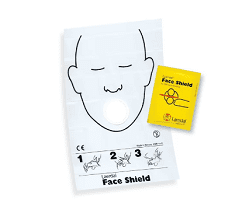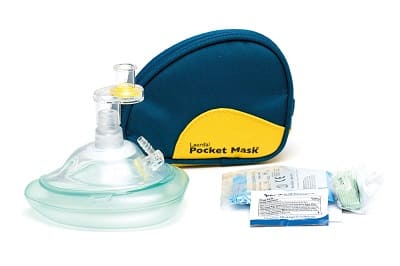Home › Scuba Guide › Gear for Divers › Accessories › Barrier Devices
Using Barriers in Emergency First Aid
Barriers and shields help to protect rescuers against disease transmission and contact with unsafe body fluids (e.g. when assisting a bleeding diver).
This section explains why barrier protection is important during any emergency first aid response and what kind of shielding is available for laypersons.
What are Good Examples of Barrier Devices
Students who use protective barriers in training courses are more likely to use them in a real emergency situation.
The devices that protect a rescuer from disease and infection include:
- CPR ventilation barrier or flat plastic vented shield
- Disposable gloves (e.g. latex or nitrile powder-free)
- Eye protection (e.g. Googles™ Eye Shields)
- Face shield for resuscitation
- Laerdal Pocket Mask™ (rescue breathing mask)
Pro Tip: You can also use improvised barriers to help reduce the risk of cross-contamination and infection, such as spectacles and robust plastic bags.
Importance of Personal Protective Equipment (PPE)
Body fluids, such as blood and saliva, may contain bacteria and infectious viruses. So, you can mitigate the risk by reducing exposure to harmful microorganisms.
PPE is part of general first aid and emergency equipment and includes different protective barriers. Protection from potential exposure to disease and infection - via patient contact - is the main purpose of using them.
You wear them to cover your hands, mouth, eyes, or your entire face. This is why divers and layperson responders should always carry barriers, either in your save-a-dive box or in a handy keychain.
Here's the thing:
There will be inherent risks for fluid exchange when administering first aid or cardiopulmonary resuscitation (CPR), especially mouth-to-mouth.
As a result, barrier devices help to protect the rescuer from the patient - as well as - the patient from rescuer. So, the use of protective equipment enhances confidence to provide care in a safe manner.
Important: Not all lay responders will be comfortable delivering rescue breaths to an unfamiliar patient. In this case, the American Heart Association recommends delivering continuous chest compressions instead.
Using Barrier Devices on a Patient
Whenever a lay responder uses a device to protect them from the person who needs emergency care, they should:
- Put on disposable gloves (several pairs if there is broken glass).
- Avoid touching the patient's eyes and any open skin wounds.
- Avoid touching other sensitive areas (e.g. the mouth and nose).
After you have finished providing care, remove all used barriers and dispose of them in the proper manner, such as inside a biohazard bag.
Remember, CPR barriers, rubber gloves, disinfectant wipes, and mouth shields are for single use only. Do not delay washing or sanitising your hands after using barrier devices.
Using a Face Shield
Modern face shields are budget-priced, single-use CPR barriers that are convenient and easy to carry, such as attached to a keychain.
 An important feature of Laerdal® Face Shields is the high-quality Technostat filter. It prevents direct contact with the victim's mouth, nose, and face.
An important feature of Laerdal® Face Shields is the high-quality Technostat filter. It prevents direct contact with the victim's mouth, nose, and face.
Having basic CPR instructions printed on it also helps to give confidence to providers to begin resuscitation.
Furthermore, small packaging means it fits into handy places, such as your:
- Car glove box
- Wallet (or purse)
Pro Tip: The EFR Primary and Secondary Care course helps layperson rescuers overcome the hesitation to start resuscitation.
Using a Pocket Mask
The most widely used CPR mask is the Laerdal® Pocket Mask. Its unique design has a filter and a one-way valve for extra protection when performing cardiopulmonary resuscitation (CPR).
 Modest distance created between the care provider and the provider allows for better viewing of patient chest movement and lip colour.
Modest distance created between the care provider and the provider allows for better viewing of patient chest movement and lip colour.
The one-way valve also filters out contaminants in the air for greater barrier protection.
Pediatric Pocket Mask
A low resistance one way valve, and circular silicone mask, makes it safer to perform CPR on a pediatric patient, such as young children and infants.
The construction of the Laerdal® Pediatric Pocket Mask allows for a tighter seal and better resuscitation of minors with small faces.